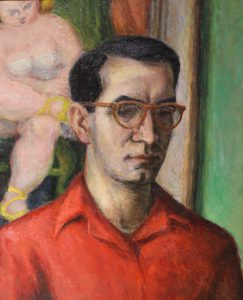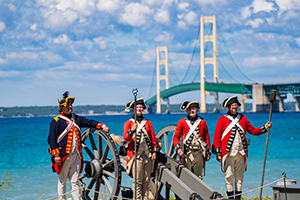
A special exhibition featuring the artwork of Stanley Bielecky is on display at The Richard and Jane Manoogian Mackinac Art Museum on Mackinac Island now through October 9, 2016. The exhibit was co-curated by Mackinac Island cottage Dr. James Bogan and Mackinac State Historic Parks Deputy Director Steve Brisson.
Stanley Bielecky was born in 1903, near Berlin, Germany. His family came to the United States when he was three and they settled in East Chicago, Indiana. A born artist, Bielecky was able to pursue his art studies by winning competitions and scholarships. He received his first formal training in the 1930s at the Minneapolis Institute of Arts with further courses at the Chicago Art Institute. Despite receiving several major art awards and exhibiting across the country, he struggled throughout his life to pursue his dream of painting. He worked as a commercial artist for several years before becoming an instructor in fine arts at Valparaiso University in 1941.
Bielecky first came to Mackinac Island in the 1930s. In the summer of 1941 he was co-founder and director of the Mackinac Island Summer School of Art. He served from 1942 to 1945 in the U.S. Army in Europe. After the war, he reassumed a position as instructor of fine arts at Valparaiso University until 1957 and began to summer on Mackinac Island. From the late forties into the seventies he painted thousands of water colors and oils of the Mackinac scene, when he was not tending bar at the Murray Hotel or driving a carriage to make ends meet. He died in 1985 leaving behind some of the most deft and spirited depictions of Mackinac painted in the twentieth century.
Bielecky’s favorite subjects were capturing the common man at work or play on Mackinac Island, his home state of Indiana, and his other favorite haunt, New Orleans. He could be categorized as an “American Scene Painter,” with a nod to Thomas Hart Benton, another sketchpad observer of real people doing real things. Sometimes he worked in the broad-bottomed manner of Reginald Marsh, who caught the vitality of Coney Island in the 1930s. Bielecky approaches the crowds of Mackinac with similar impious dash. His compositions are deceptively simple, ranging from flat, near-cubist to flowing, three-dimensional elegance. Contemplate any of the “Blue Series” paintings for a lesson in how to multiply blue into blues.
Stanley Bielecky was dapper, hardworking, an impeccable bartender at night, and a prolific painter by day. However, he did not part with his creations easily. Paintings could not be bought, only “acquired,” and then solely by those who would view them with friendly eyes. Art, not commerce, was his master. Relentless dedication to his vocation resulted in a life’s work of singular integrity–and exuberant beauty. That we enjoy these paintings today testifies to how thoroughly the artist’s spirit animates them.
Our thanks to Dr. James Bogan who contributed to this article.









